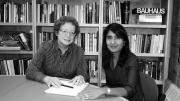“I like doing things that are impossible,” says Ellen Faran ’73, M.B.A. ’81, “and there’s nothing more impossible than university-press publishing.” As director of MIT Press, she and editorial director Gita Manaktala ’87 tackle a daunting task. “We’re trying to get very specialized information to a very small audience,” Faran explains. “We want to do that well, and at reasonable prices.”
The nonprofit press publishes leading-edge, highly specialized academic books, journals, and textbooks, drawing on scholars from around the world. As editorial director, Manaktala oversees book acquisitions in the press’s 16 main areas of interest, which include humanistic fields like architecture and linguistics in addition to the hard sciences. She describes her job as a process of “hunting and gathering”— contacting scholars in the field to suggest book projects and evaluating existing proposals and manuscript submissions. The publication process has several levels of scholarly involvement, from the subject experts who evaluate the proposals to peer reviewers, series editors, and postpublication reviewers who provide commentary and feedback. “We draw on the expertise of scholars in these fields to help us make good publishing decisions and improve what we publish,” she says. “The culture of academe is strikingly generous.”
Both women say the press has a long tradition of innovation and exploration. “One thing that distinguishes us from other university presses is that we tend to work at the edges and intersections of our fields rather than the center,” Manaktala explains. That has helped shape the emergence of new areas of inquiry, she says: in the 1980s, the press had an influential role in publishing work from the fledgling field of cognitive science, and it continues to publish the Journal of Cognitive Neuroscience today; it also sponsors an online research platform called CogNet. As the press celebrates its fiftieth anniversary this year, it looks back at a history of groundbreaking books, including the monumental Bauhaus: Weimar, Dessau, Berlin, Chicago, by Hans Wingler, Word and Object, by Willard Van Orman Quine, Ph.D. ’32, JF ’36, LL.D. ’79, and Aspects of the Theory of Syntax, by Noam Chomsky, JF ’55, LL.D. ’00. More recently, the press has been exploring new media, game studies, and digital humanities, now one of its acquisitions areas. Sometimes, says Faran, the press publishes a book even before there are “classes to read it—which gives our marketing people a big challenge.”
Such are the sorts of difficulties faced by an academic press. But Faran, who worked for several commercial presses, including HarperCollins and Houghton Mifflin, before being appointed to her current job in 2003, says that life at a university press has many benefits. “We’re trying to connect academic authors with readers,” she says. “You’re working for a mission to advance knowledge.” The directorship, she says, “is really the job of my career-long dreams.”
She and Manaktala both emphasize the rewards of working with scholarly material. Manaktala calls publishing, and academic publishing in particular, a great field for anyone “interested in ideas and the wider world.” Of her own experience, starting as a marketing assistant with the press just out of college, she says, “I would hole up in one of these offices at lunchtime and just take books off the shelves. I was in heaven! It’s been this remarkable education for me, in all these fields I never got a chance to study in school.”
Both women have witnessed enormous changes in the publishing industry. The press now makes many of its publications available digitally and is exploring other reading platforms as well, like apps for mobile devices: “Many of our activities,” says Faran, “are complementary to each other.” But the focus on new and startling topics remains. One of Manaktala’s recent favorites is Design Meets Disability, Graham Pullin’s exploration of how fashion and design can revolutionize implements like hearing aids and prosthetic limbs in the same way they have transformed eyeglasses. Faran points to Open Access, by Peter Suber, director of the Harvard Open Access Project; the book is part of the press’s Essential Knowledge Series. “Other presses are scared by open access,” says Faran. “We’re publishing books about it.” The press, says Faran, is constantly adapting and looking to the future. “Publishing is not a place for a person who needs structure, stability, and predictability,” she says. “But it’s an amazing job for someone who can imagine the possibilities.”









